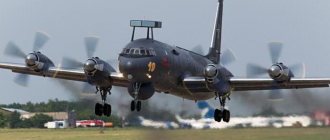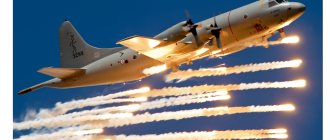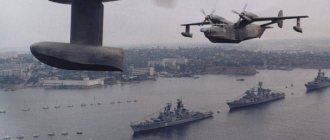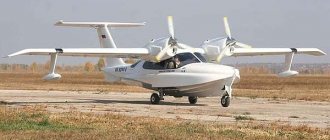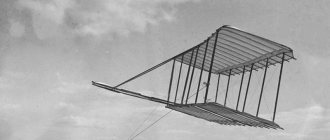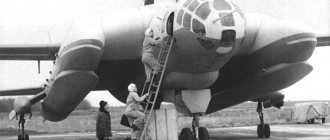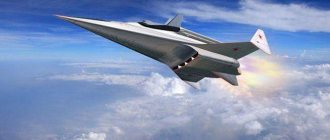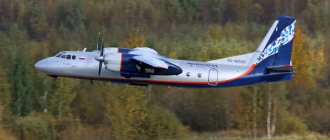History and reasons for creation
In the late fifties of the 20th century, the US Navy began developing the first Polaris missile submarines (SSBN-608 class USS GeorgeWashington, first commissioned on December 30, 1959).
Due to range and accuracy limitations, the Polaris A-1 missile had to be launched from a position fairly close to the coast of the destination country—especially one like the Soviet Union. Consequently, the MA of the USSR Navy (Maritime Aviation of the Navy of the Soviet Union) in 1956 demanded an aircraft capable of detecting and destroying nuclear missile submarines in the coastal waters of the USSR.
It was assumed that land ships or radio direction-finding stations oriented toward the shore would indicate the approximate location of the enemy submarine.
The aircraft will then track with short-range radar, sounding and sonar to find and classify the target. If successfully detected, the attack will usually take place in cooperation with surface ships.
Even though the Be-6 (pictured) was gradually improving, the Navy MA needed a larger aircraft capable of carrying all the necessary weapons and modern sensor equipment.
At that time, the Be-10 aircraft project was being developed in parallel, the predecessor of which was the R-1 (the first Soviet jet seaplane). The main difference between the Be-10 and Be-12 aircraft is that the former has jet engines, but the purpose of creating these aircraft was one - to counter enemy submarines and patrol the coastal area.
At the same time as the Be-10 was being developed, Beriev began work on an entirely new design for a slower but more comprehensively equipped aircraft. In the late fifties, Beriev is believed to have personally made an experimental flight in a Be-6 equipped with new turboprop engines.
This likely led to the further development of a turboprop-powered aircraft based on the Be-6 layout. The design decision was presented to officials in November 1957 and was soon adopted.
Both the Be-10 and Be-12 were first shown to the rest of the world at the Aviation Day air show at Tushino Airport in Moscow on July 9, 1961. The two-hour demonstration featured a group of aircraft consisting of four Be-10s followed by one example of a Be-12.
Western observers were told that the Be-10 had already entered service with the Navy's MA and they assumed that the Be-12 was just a one-off turboprop child of the aging Be-6. According to NATO classification, the aircraft were named “Mallow” and “Mail”, respectively.
The first prototype adopted the old search radar unit used on the Be-6 and made its first flight on October 18, 1960. Unfortunately, it crashed on November 24, 1961 with the death of 3 crew members.
The second prototype received a number of design changes, including moving the engines below the wings above the wings and adding the famous radar on the nose.
Who saw the radar?
It made its first flight in 1962 and was immediately sent for development tests. After long discussions among the highest ranks of the naval aviation command, the Be-12 project was nevertheless approved for service in the MA of the USSR Navy.
Serial production began in 1963 at a plant in Taganrog. Production ceased in 1973 after 143 aircraft (including prototypes). Then production switched to Tu-142 and Tu-142.
The Be-12 officially entered service with the Navy MA in the spring of 1964.
The aircraft received the unofficial nickname "Seagull" due to its wing shape.
The main function of the aircraft is patrolling, at a distance of up to 500 km from the coast. By 1967, the Be-12 replaced the Be-6.
Ultimately, these aircraft's missions included coastal surveillance, reconnaissance, anti-illegal shipping patrols, aerial photography, cargo transportation, and search and water rescue.
Design of the GTS flying boat
The plane was a twin-engine flying boat of metal construction - a strut-braced monoplane with a high wing. The wing was mounted above the fuselage on a streamlined pylon. The boat's hull was relatively wide, low and rounded at the top. The fuselage was divided by five duralumin watertight bulkheads with sealed hatches for passage into six isolated compartments. This provided buoyancy in case of damage to the outer plating of the bottom of one or even several compartments. In the bow there were hatches for the anchor and mooring cable.
The GTS radio equipment consisted of a main and emergency transmitter, two radio receivers and two direction finders. The boat was equipped with an autopilot and had an internal telephone connection.
Electricity for lighting, operation of on-board equipment and weapons was generated by two batteries and two engine-driven generators.
The crew of the seaplane included two pilots, a navigator, a radio operator, a flight mechanic and two gunners.
The machine had a rather complex and labor-intensive design. For this reason, as well as in connection with the organization of serial production of the Che-2 flying boat by Igor Vyacheslavovich Chetverikov, the production of the GTS was discontinued at the end of 1940.
In total, 27 GST aircraft were built at the Taganrog plant, in addition, two PBY-1 boats were assembled from American parts with Wright Cyclone engines.
Design features
The Beriev Be-12 featured a high wing with two oval vertical stabilizers. The Be-12 was equipped with two turboprop engines, as well as retractable landing gear, which gave it the ability to land both on conventional runways and at sea.
Instead of the NK-4, the Be-12 ran on Ivchenko-Progress AI-20D turboprop engines - initially 3 series (20DK), later 4 series (20DM) with a power of 3.865 kW, variable pitch drive propeller. An auxiliary power unit at the rear of the fuselage provided launch and flight power.
The exhaust air was used to remove ice from the surface of the glass and the engine air intake. Electrothermal systems were used to defrost the windshield and pitot tube.
Notes
- ↑
- ↑ Error in footnotes?: Invalid tag ; no text provided for footnotes
- ↑
- ↑ A. Zablotsky, A. Salnikov. Amphibious aircraft Be-12.
- “A corner of the sky. Be-12SK Chaika"
- S. V. Drozdov.
Between the Yak-42 and the “Superjet” (Russian) // Wings of the Motherland. - M., 2022. - No. 7-8. — P. 198. - S. V. Drozdov.
Between the Yak-42 and the “Superjet” (Russian) // Wings of the Motherland. - M., 2022. - No. 7-8. — P. 203. - S. V. Drozdov.
Between the Yak-42 and the “Superjet” (Russian) // Wings of the Motherland. - M., 2022. - No. 7-8. — P. 203. - (unavailable link). RosBusinessConsulting (October 12, 2012). — The plane, performing a training flight, crashed while landing. Retrieved October 15, 2012.
- The Military Balance 2016
- Military Balance 2017
Equipment and weapons
To combat enemy submarines, the aircraft could use the PPS-12 system and the NKPB-7 collimator sight for more accurate bomb drops and visualization of the process.
View of the navigator's seat from the nose of the Be-12 aircraft
For anti-submarine bombing, two types of bombs PLAB-50 and PLAB-250-120 were used. And also for more effective destruction of an enemy target, it was possible to use the AT-1 and later AT-1M torpedoes.
Later in the modification process, the aircraft was modified to install Scalp nuclear bombs on it, which could be used underwater. For aircraft of this modification, special attention was paid when installing heat-resistant skin and hull, and an improved electrical system was also installed.
Radio operator position in the tail of the aircraft
An important device was a code-locking system to prevent the accidental use of a nuclear charge on board.
TTX Be-12
- Crew of 4 people, of which: 2 pilots, navigator, radio and sensor systems operator
- Dimensions : length 30.11 m; Height 7.94 m; Wingspan 29.84 m; Wing area 99.00 sq.m.
- Engines : two turboprop engines AI-20DK or AI-20DM with a power of 3.863 kW or hp: 2 x 5180
- Weight : empty operation 24,500 kg, maximum load 36,000 kg
- Performance : maximum speed 530 km/h, at an altitude of 3050 m
- Cruising speed 320 km/h, at an altitude of 300 m
- Initial ascent speed 912 m per minute
- High ceiling 11,000 m
- Range with full load 1500 km
- Maximum weapon load 3000 kg
- Normal weapon load 1500 kg
Key dates in the life of the Be-12 amphibious aircraft
| March 28, 1956 | The Soviet government issues an official order to replace the Be-6 aircraft |
| November 1957 | Be-12 project submitted for approval |
| June 30, 1960 | The first prototype of the Be-12 is completed |
| October 18, 1960 | Flight of the first prototype |
| July 9, 1961 | The first public appearance of the first prototype was at the Tushino Air Show |
| November 24, 1961 | First prototype accident, with the loss of three crew members |
| September 1962 | Second Be-12 prototype completed |
| July 19, 1963 | State testing has begun |
| December 12, 1963 | The first production aircraft Be-12 was completed |
| Spring 1964 | Be-12 is part of the Navy MA |
| November 29, 1968 | Be-12 officially accepted into Navy service |
| November 1973 | Serial production ends with the last new version of the Be-12PS. |
| April 27, 1992 | The Be-12P bomber prototype makes its first flight. |
| July 23, 1993 | Be-12P was used to fight fire near the village of Listvyanka. |
| October 6-11, 1994 | The Be-12NX was used to deliver 30 tons of cargo to victims of the earthquake in Yuzhno-Kurilsk. |
Various modifications of the Be-12 aircraft
| Model names | Modification features |
| M-12 Stripped down example of the Be-12 | Used for intermittent flights. All unnecessary equipment has been removed and the crew has been reduced to two people. |
| Be-12LL | One aircraft modified to test the homing system of the 3M-80 Moskit anti-tank missile. The nose radar is replaced by a conical missile head. Equipment monitoring is located in the weapons compartment. |
| Be-12N (product "EN") | Equipped with a computer-controlled Narcissus search/attack system. |
| Be-12P (product "EP") | Recycling the aircraft to fight fires. Equipped with a 4500-liter tank and a water discharge system. |
| Be-12P-200 | It is an analogue of the Be-12P, only in its modern form. Modified in 1994. |
| Be-12PS (product "ZE") | A shortened version of the Be-12 with life rafts and a survival kit in capsules. Additional fuselage hatch under the rear edge of the starboard side. |
| Be-12SK (product "ESK") | One aircraft converted to carry a Scalp nuclear warhead. |
| Be-14 (product "EPS") | Advanced modification for 24/7 operation. Used for search and rescue operations. Built in one copy. |
Surprisingly, despite its age, it is still in service, with a strength of about 150 aircraft.
Some have been converted from military aircraft into firefighting aircraft, capable of dropping almost 7,000 liters of water or fire retardant on forest fires.
Retired examples of the Beriev Be-12 are in the Central Air Force Museum near Moscow and in the State Aviation Museum of Ukraine in Kyiv.
Surviving copies
| Type | Board number | Location | Image |
| Be-12 | 74 | Lugansk Aviation Technical Museum, Ukraine | |
| Be-12P | RA-00041 | Taganrog Museum of Aviation Technology, Russia | |
| Be-12 | 35 | State Aviation Museum of Ukraine | |
| Be-12 | 25 | Central Museum of the Russian Air Force | |
| Be-12 | 15 | Training Airfield ShMAS Navy, Vyborg. Disposed of in 2014 | |
| Be-12 | 07 | Museum of the World Ocean, Kaliningrad, Russia | |
| Be-12N | 55 | Museum of the Northern Fleet Air Force, Safonovo (Murmansk region) | |
| Be-12N | 15 | Yelizovo, monument to an aviator of the 317th regiment | |
| Be-12 | 87 | Aviators' Square in Mirny (Donuzlav), Crimea | |
| Be-12 | 02 | h.ch. 4465, Nikolaev, st. Aerodromnaya 1 (Gorky village, or new watering hole) | |
| Be-12 | 05 | h.ch. 4465, Nikolaev, st. Aerodromnaya 1 (Gorky village, or new watering hole) |
